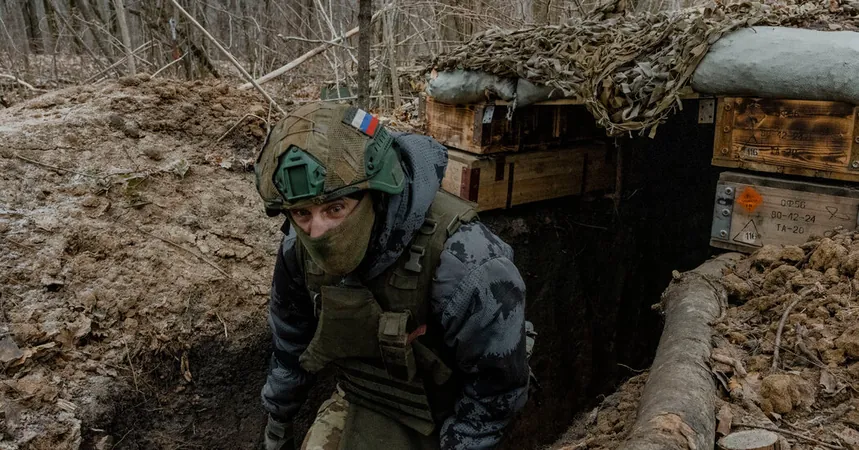
The Dramatic Collapse of Ukraine's Offensive in Russia's Kursk Region: What Went Wrong?
2025-03-16
Author: Ming
Introduction
In a surprising turn of events, Ukrainian forces have nearly withdrawn from the Kursk region of Russia, marking the end of a bold offensive that had taken the Kremlin by surprise last summer with its swift advances.
Eyewitness Accounts
Eyewitness accounts from the frontlines reveal a retreat that varied from organized to disorganized, as Russian troops aggressively pushed forward, effectively forcing Ukrainian soldiers back to a narrow strip along the border. According to one platoon commander—identified only by the call sign 'Boroda'—the situation became dire: their vehicles were obliterated, drones relentlessly chased them, and their ammunition was nearly depleted. As forces closed in from all sides, he stated, "We had no choice but to retreat."
Territorial Changes
This platoon took two days to trek over 12 miles from their last held position near Kazachya Loknya to reach the Ukrainian border, only to discover that Russian forces had occupied their previous territory. At the peak of the offensive, Ukraine had control over approximately 500 square miles, but as of this weekend, they clung to barely 30 square miles, according to Pasi Paroinen, a military analyst with Black Bird Group based in Finland. “The end of the battle is approaching,” he noted.
Current Situation
While independent verification of the territory still in Ukrainian hands is challenging, reports of intense fighting persist. Current battles seem less about holding land and more focused on preventing a surge of Russian troops into Ukraine's Sumy region, which could open another front in this ongoing war. "Our defensive positions have simply shifted closer to the border," said Boroda.
The Operation's High Stakes
The operation in Kursk may have seemed like a high-stakes gamble, resulting in heavy losses for Ukraine at a time when their forces were already stretched thin across a lengthy front. Nevertheless, it delivered a morale boost as Kyiv sought to demonstrate that it could bring the fight onto Russian territory, potentially using these gains as leverage in future ceasefire discussions.
Consolidation of Russian Military Power
The timing of this retreat coincides with the consolidation of Russian military power, which in many ways was accelerated by the Trump administration's push for a rapid truce, just as Ukraine was trying to halt Russia's advancement in Eastern Ukraine.
Factors Contributing to Ukraine's Difficulties
Several factors contributed to Ukraine's faltering position in Kursk. Russian forces relentlessly targeted supply lines and severed evacuation routes. The introduction of North Korean troops, who initially struggled, saw improvements in their combat capabilities as well. Added to this complexity, vital U.S. military support and intelligence sharing were reportedly suspended, adding to the Ukrainian forces' challenges.
Critical Infrastructure Losses
When we last reported from the border in January, the skies were filled with Russian drones, complicating any movement. The road from Sumy to Sudzha was strewn with the remnants of combat—burned-out cars and destroyed military vehicles.
Deployment of Seasoned Brigades
Ukrainian commanders had deployed some of their most seasoned brigades to the Kursk front. However, the relentless assaults from Russian forces, coupled with the increased presence of thousands of North Korean soldiers, led to a mounting toll. As the situation deteriorated, reports indicated that Russian forces were using drones for ambushes, laying traps along critical supply routes with devastating effectiveness.
Infrastructure as a Target
Critical infrastructure, notably bridges, became prime targets for Russian airstrikes and drone strikes, leading to restricted mobility for Ukrainian troops. "The destruction of the bridges was a key reason for our rapid withdrawal," articulated Artem, a senior brigade commander. Many soldiers resorted to burning their equipment to keep it from falling into enemy hands.
Impact of U.S. Military Aid Suspension
On March 3, the announcement regarding the suspension of crucial U.S. military aid marked a watershed moment for the Ukrainian forces. The sudden halt in American intelligence proved debilitating, especially for the use of the advanced HIMARS rocket systems which require precise targeting. When Russian troops executed a surprise maneuver on March 8, the chaos that ensued was enough to trigger a hasty Ukrainian withdrawal.
Troop Encirclement
Despite varied reports of troop encirclement, military analysts and on-ground accounts have indicated that at no point were large Ukrainian forces effectively cornered. As Ukrainian soldiers retreated along designated lines, reports emerged confirming Russia's advance toward Sudzha, which has recently been retaken along with surrounding villages.
Repercussions of the Offensive
The repercussions of the Kursk offensive are far-reaching, as both sides have suffered significant losses, and the once-vibrant town of Sudzha, with its population of 5,000, now resembles a battlefield scarred by conflict. The unfolding dynamics along the border highlight the precariousness of both military strategies and alliances, suggesting that the conflict is far from over and could escalate further in the weeks to come.




 Brasil (PT)
Brasil (PT)
 Canada (EN)
Canada (EN)
 Chile (ES)
Chile (ES)
 Česko (CS)
Česko (CS)
 대한민국 (KO)
대한민국 (KO)
 España (ES)
España (ES)
 France (FR)
France (FR)
 Hong Kong (EN)
Hong Kong (EN)
 Italia (IT)
Italia (IT)
 日本 (JA)
日本 (JA)
 Magyarország (HU)
Magyarország (HU)
 Norge (NO)
Norge (NO)
 Polska (PL)
Polska (PL)
 Schweiz (DE)
Schweiz (DE)
 Singapore (EN)
Singapore (EN)
 Sverige (SV)
Sverige (SV)
 Suomi (FI)
Suomi (FI)
 Türkiye (TR)
Türkiye (TR)
 الإمارات العربية المتحدة (AR)
الإمارات العربية المتحدة (AR)